CanucksArmy’s 2018 “Midterm” Prospect Rankings: #3 Olli Juolevi
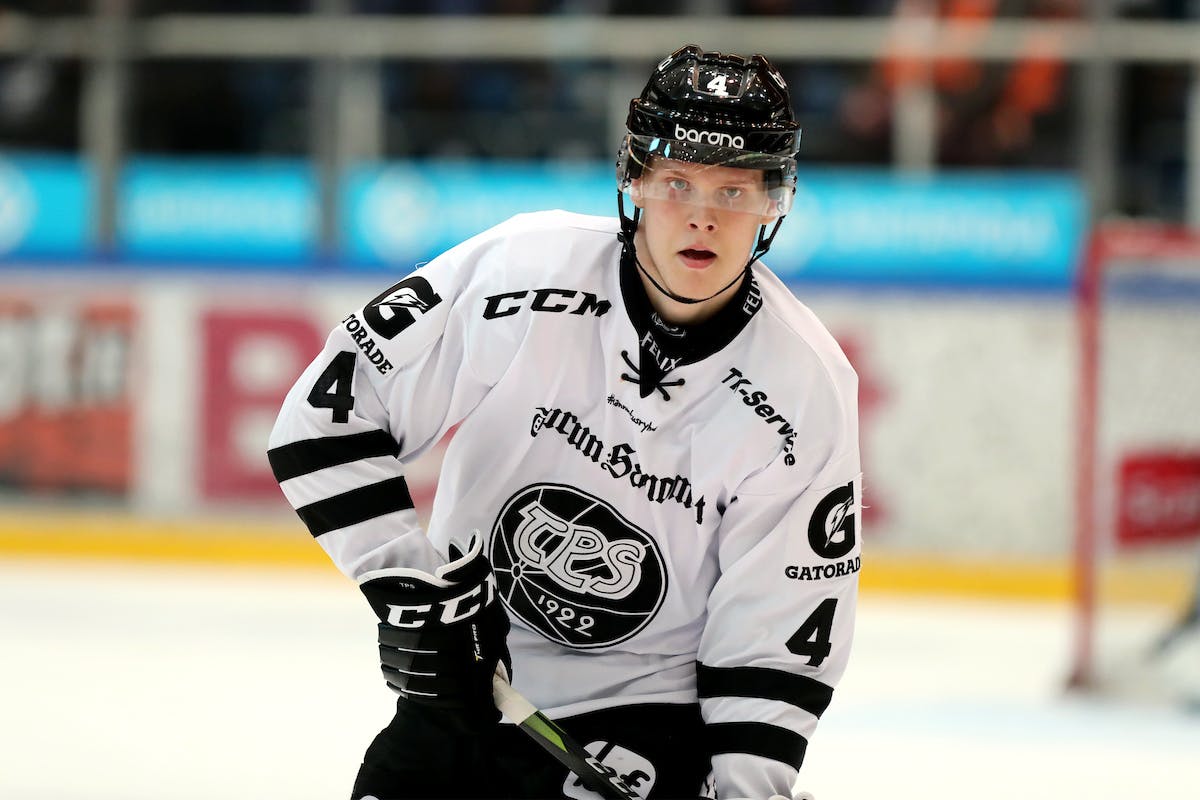
5 years ago
Rounding out our top three prospects in the organization is 2016 draft pick Olli Juolevi.
There is plenty to discuss and dissect about the Finnish defenceman, and we will below, but there is little doubt that he is the organization’s top defensive prospect and should be a part of this team for quite a few years ahead.
He made his way to Finland this past season and could push for a roster spot as early as next season. So, let’s dive in and take a look at Olli Juolevi.
Numbers:
Olli Juolevi 2017-18 Liiga Statistics
| GP | G | A | P | S | S% | CF% |
| 38 | 7 | 12 | 19 | 114 | 6.1% | 53.6% |
Averaging 17:52 in ice time per game, Olli Juolevi was able to post 0.5 PPG as a rookie. That clip allowed him to finish four in voting for Liiga Rookie of the year, despite only playing in 2/3 of the season for TPS. His shot rates of 3.0 SH/PG is encouraging for any player but particularly noteworthy for a defenceman, let alone a rookie.
He followed that up with two goals and five assists in the postseason in eleven games, which was seventh among all defencemen in Liiga, despite playing the fewest games of that top twelve. His shot rate increased to 4.18 SH/PG in the post-season in large part to increased ice-time (22:57) and power-play time in the playoffs.
pGPS:
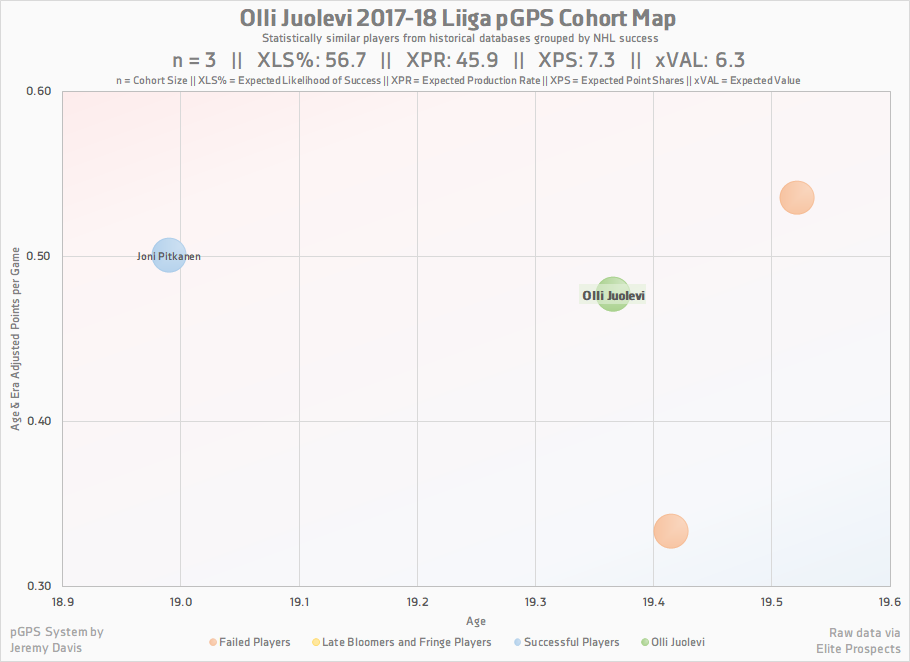
Based on pGPS, an impressive 56.7% of his statistical cohort went on to become NHL regulars with an expected production of 45.9 points at their peak. With that said, there is only the one successful player (Joni Pitkanen) out of the three matches, which makes this number potentially misleading as the cohort is small. We’ll talk about it below but Juolevi’s different path this season is a primary reason for the lower (n) and thus should be taken as just a small layer of analysis.
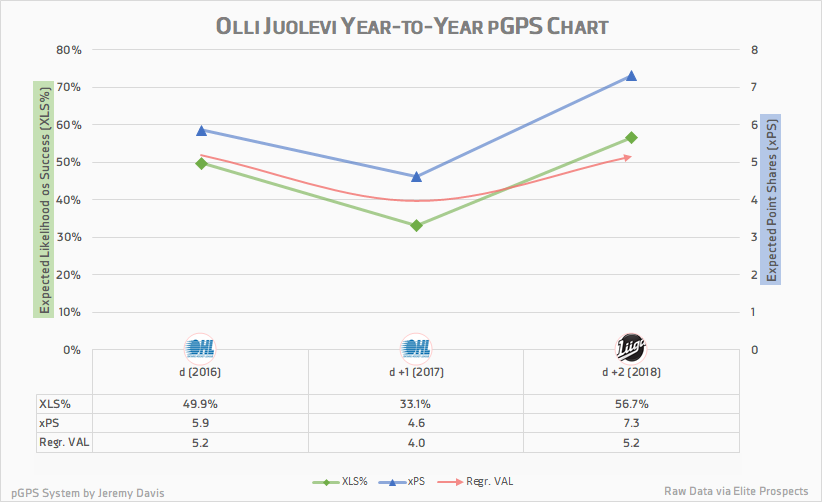
That dip last season was due to him producing the same amount of points as he did in his draft year. The increase is due to the smaller sample size in Liiga but still encouraging and fair to suggest that he is trending back to where he was previously.
Scouting Report
Whenever anyone discusses Juolevi, there are a few things that need to broaching before you really dive in — almost a disclaimer on how to properly evaluate him as a prospect. Firstly, Juolevi will be an NHL player for an extended period for the Canucks. His smarts, awareness, puck movement and distribution skills will allow him to be effective at the NHL level and carve out a long career.
With that out of the way, the Canucks selecting Juolevi over some other players is not a way to accurately analyze him as a player. The organization felt he was the best player available. It is not Juolevi’s fault that happened nor should it garner consideration when evaluating him. The argument can be made the Canucks should’ve chosen Mikhail Sergachev, Jacob Chychrun, and Charlie McAvoy (two of which CanucksArmy had ranked higher). Still, they felt that Juolevi was better. The expedited timeline of those other three has cast a more massive cloud over the pick.
With that out of the way, let’s look at the Canucks prospect’s game and this season in particular.
The 20-year-old defenceman — Juolevi’s age is an essential aspect in allowing time before fully saying the Canucks made the wrong selection — had an up and down season in Liiga but his work overall can be classified as a successful step forward in his development. He started the season a little rough:
When he first arrived in Finland, there was some obvious rust and timidness to his game, and it showed when watching him and then in the event tracker above. In his first ten games with TPS Turku, Juolevi was on the ice for ten 5v5 goals against. He was on the ice for 15 more 5v5 goals against over the course of the other 28 regular season games while contributing offensively. There was a dip in production upon his return from the World Juniors, that saw him sit out a couple of games. But he closed out the season well and was very effective in the playoffs.
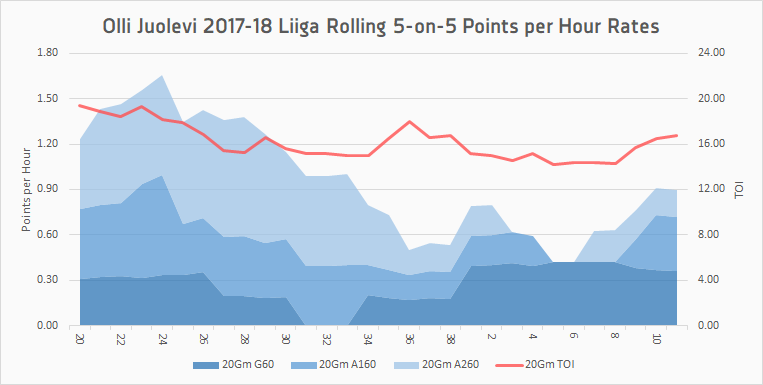
His rolling rates tell a similar story as the event tracker in that he started the season slowly but by the twenty game mark had hit the ground running. That dip occurs, but he starts to trend back upwards towards the conclusion of the season and into the playoffs.
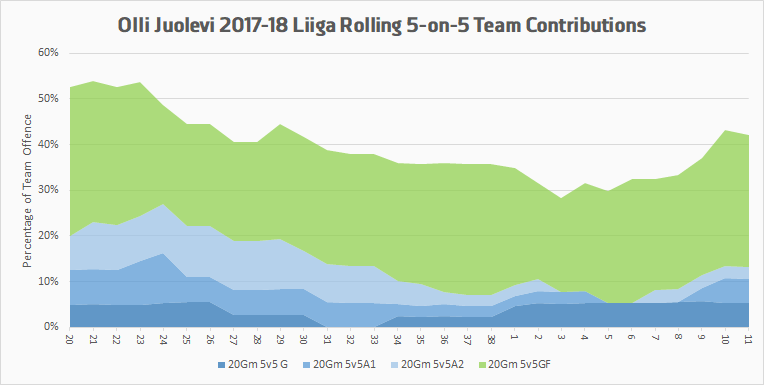
From a qualitative standpoint, and I mentioned this when looking at the data above, is that Juolevi started the season behind, worked himself out of it, played well at the WJHC, had another dip, and then worked back out of it. The first part of his season was a combination of things including being timid on the ice, some rust to his game, and being over-matched regarding strength.
When he reached the ten game mark, he was being more aggressive with his engagements and stick work. He was smartly reading oncoming opponents with the puck and using his skill set to guide them into low danger situations. There was some still some struggles to contain a few players, which isn’t uncommon given he was a teenager in a professional league, but he was putting himself in situations where he wasn’t getting burned.
Juolevi was able to move the puck out of the zone very well and join the rush – which coincided with his uptick in offence and shot rates.
There is little doubt that he will need to get stronger in his upper body to handle NHL players and the rigours of a full season in the NHL.
Offensively, it would be ideal for Juolevi to improve his shot as well. He regularly relies on his wrist shot (with a leg kick) to get pucks to the net. He is very effective at getting the puck past the first opponent and near the net, but adding a slap-shot to the arsenal will allow Juolevi to get more opportunities at 5v5 and PP to generate offence. That will ideally come with the added strength.
The Helsinki native still has a penchant for moving the puck out of his zone effectively. There is little doubt that is one of the strengths of his game. His performance at this past World Juniors, particularly Finland’s final game, was a tease of why the Canucks thought he was the best player available.
It’s fair to say that Juolevi didn’t take a step forward in his development in his draft plus one season with the London Knights but has reset the ship with his draft plus two season this past year with TPS Turku. There was some encouraging signs about his play and then some things to keep an eye on going forward. Some of those issues will be fixed with some more development as a player and as a young man.
The organization will likely give Juolevi every chance to make the Canucks out of camp but he likely ends up in Utica to start next season, which isn’t a bad thing. He will be able to be the number one guy for the Comets and be supported by some veteran prospects, like Ashton Sautner or Evan McEneny, and AHL vets, like Jamie Sifers. It will allow Juolevi to ease into the AHL and then go from there.
That ultimately is the best course for a 20-year-old defenceman who is still rounding out his entire game. After that, I’d expect the former fifth overall pick to make his way onto the Canucks sooner rather than later. It’s just a matter of where his ceiling will take him.





